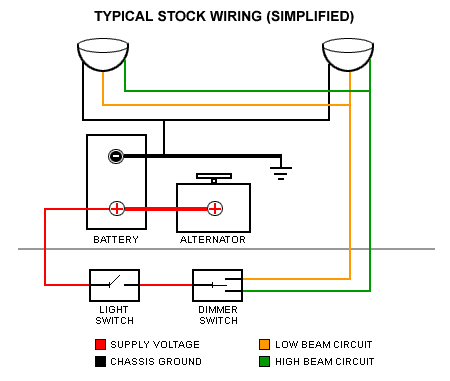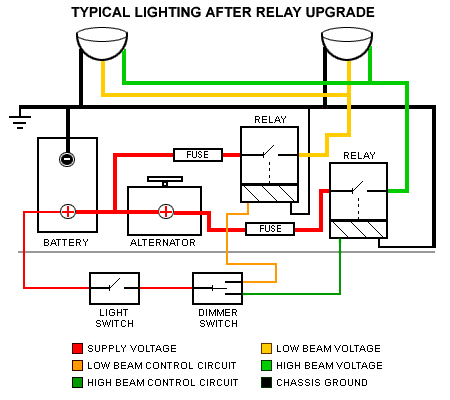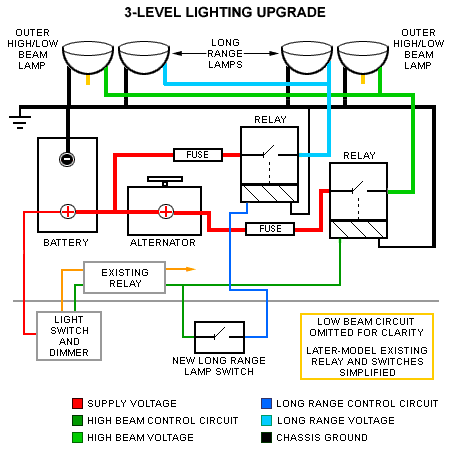
 |
Archive Index | Current Issue | |
|
|
||
David A. Hueppchen OJ Rallye Automotive OJRallye@vclassics.com The first part's easy. Your grandmother can do it. Clean your lenses. Dirt and road grime can block a large percentage of the light output. The headlamp lenses catch more dirt, road grime, mud, bugs, whatever, than the windshield does, because of where they're positioned on the car. The next step is a little more involved, but has been accomplished by many do-it-yourselfers. No matter what type of headlamps you have, whether they're American sealed beams or European H4 lamps, a large increase in light output can be achieved by supplying the full system voltage to the headlights -- or as close to it as possible. Longer and/or thinner (higher gauge number) wires reduce voltage. Each electrical connection causes a small voltage drop. Switches cause more voltage drop. Voltage drop reduces light output. Halogen lights, when operating at 100% voltage, produce 100% of the designed light output. At 95% of the voltage, the light drops by more than 15%; at 90%, it drops by a third! With a typical 12-volt system operating at 13.5 volts, loss of a mere 1.35 volts is 10%. In our classic Volvos, the current flows from the engine compartment into the cockpit and to the headlight switch, and then, depending on the vintage, either to the dimmer switch on the floor or to the headlamp relay. That relay really only switches between high beam and low beam and allows you to flash the high beams.
 To short-cut this circuit and eliminate the voltage drop (or mininize it, at least), we install additional relays. A relay is a remote control switch. It requires very little current to operate and can remotely handle the heavy current we want to get to the lamps. The relay should be mounted under the hood, receiving power from a good source, i.e. the junction block on the inner fender on some cars, the alternator output terminal, or the starter solenoid terminal. We run power to the relay using 10- or 12-gauge wire; to protect the circuit, we install an in-line fuse in this wire. Then, we run the same gauge wire from the relay to the headlamp using a heavy-duty connector. 12-gauge wire is the minimum; for over-wattage bulbs, we use 10-gauge. On the other side of the headlamp, we install the same gauge wire going to a good, new, clean ground, to allow the current to flow the rest of the way through. We now have a relay half wired. Since the operating current requirements of the relay are small, the existing headlight wiring can go to the relay to control it and an 18-gauge wire can be used to ground the relay.
 Ok, that's not too hard, is it? So, if you can do it once, you can do it again. But -- how many relays do you need? A minimum, using 40-amp relays, is one for the high beams and one for the low beams. For maximum overkill on a rally car, we use a separate relay for each beam and run the wires for the lamps along each side of the car, in case a corner gets crunched. In the case of 200-series Volvos that have the bulb-out sensor function, to maintain this function we use a minimum of three relays, one for the high beams and one for each low beam, picking up the low beam circuit from each side of the car at the harness connection just behind the radiator support. An option for the four headlamp cars is a three-level beam system that can be achieved by installing an additional switch and relay that controls the inner, high beam only headlamps (the outer headlamps are both high and low beams). To wire this, the high beam power is run from the existing high beam circuit to the switch, to the control terminal, on a separate relay that operates the inner high beams. With this in place, you can be driving on a two-lane highway with the high beams on and, when you see headlamps or tail lamps in the distance, instead of switching to low beam you can flip the switch and just extinguish the longer range, high beam only headlamps. These have generally a longer range than the somewhat compromised two-beam lamps have, leaving you a little more light until it is actually time to switch to low beams.
 Want to jump into deep doo-doo? Perhaps you'd like a little basic information about wiring first. Using the cheapest relays, terminals and wire may not give you much of a gain, and may not last very long. This is one area where I don't try to save $20 doing this job. Professionally crimped terminal connections will last a long time. Soldered terminal connections will last longer. Some consideration to heat and moisture should be given when choosing places to mount the relays. The routing of the wires needs the same consideration, plus you want to avoid sharp edges and other potentials for chafing or damaging the wire. Make liberal use of tie-downs.
By the numbers: As you are seated in the car looking at the back of the headlamp, the three terminals for round headlamps, H4 bulbs, are: Left terminal 31, the ground; 56a is the one to the right, the high beam; 56b, on the top, is the low beam. They didn't ask me when they designed quad rectangular sealed beam headlamps. When viewing the terminals from the same seat, the top terminal is the ground, the left terminal is the high beam, and the right terminal is the low beam. If you have replaced your quad rectangular high-low beam headlamps with European H4 lamps, this is the reason the short pigtail adaptor was included. You already found out the terminal arrangement was changed if you thought that you didn't need the adaptor and that your existing headlamp harness was long enough, and you tried using your headlamps that way. Finally, to overcome your wiring phobia, only think about one wire at a time, make each end proper and in the right place, and be careful where you have the middle.
|